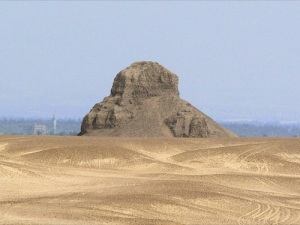
Djoser Pyramid Complex at Saqqara, Egypt. Note the large man made holes in the ground near the Step Pyramid that were used to store grain. They were most likely made by Joseph, the designer of the Step Pyramid, also known as Imhotep.
If it is true that Joseph and Imhotep were the same person, then the first pyramid (the Step Pyramid in Saqqara) was designed by an Israelite at the beginning of Israel’s Sojourn in Egypt. What’s more, if the last of the great pyramids (those of the 12th dynasty) were constructed with a core made from mudbricks which were made by Israelite slave labour, then the Israelites were in Egypt while all of the great pyramids were being constructed. When the Israelites departed from Egypt in the 13th dynasty, lead by Moses, there were not enough slaves in Egypt to make construct pyramids any more. If this is correct, the Pyramid Age coincides with Israel’s sojourn in Egypt and all of the Great Pyramids would have been constructed over a period of around 430 years.

The Black Pyramid of Amenemhet III. The inner core made of mud bricks is exposed. Josephus records that the Israelite slaves were given the task of building the Pyramids. The Pyramids of the 12th dynasty had an inner core that was made of mud bricks.
Egypt’s wealth and power reached it’s peak in the 12th dynasty under Sesostris III and his son Amenemhet III but as they had no successors, the Middle Kingdom started to fall apart when they died. Moses, an Israelite baby, was adopted by the Princess Sobekneferu and groomed to be the next Pharaoh (Amenemhet IV). Amenemhet IV did in fact co-reign with Amenemhet III for a period of 9 yrs but when he had to flee to Midian at the age of 40 years, there was suddenly no successor for Amenemhet III. Amenemhet III’s daughter Sobekneferu had to take over the reigns when Amenemhet III died. She only lived for another 4 yrs and when she died, the 12th dynasty ended, Egypt fell into turmoil and became politically unstable. There was a quick succession of Pharaohs in the 13th dynasty until Neferhotep who was the Pharaoh who was ruling when Moses (Amenemhet IV) returned from exile in Midian. After a series of ten plagues that were inflicted on Egypt, Neferhotep let Moses take the Israelities into the desert. When they did not return, he pursued them with his army. The Israelites were able to cross the red sea at the Gulf of Aqaba but Neferhotep and his army drowned when they tried to follow.

Moses and the Israelites Crossed the Red Sea at Nuweiba in the Gulf of Aqaba in 1446BC.
Not only did Egypt lose its slave labour force, it lost it’s monarch, it’s entire army and it’s transportation system. It was a massive defeat and not something that Egyptian historians would want to memorialize.
When the Israelites left Egypt, Pharaoh and his son died and all the Egyptian army drowned in the Red Sea taking all of Egypts chariots with them. Egypt was then thrown into turmoil. Thy Hyksos were able to take power and Egypts second intermediate period followed (until the Hyksos were finally defeated in the 18th dynasty).
The Israelites, therefore, had a profound influence on Egypt having designed the first pyramid (in the third dynasty) and having provided slave labour for various public works which included making mudbricks for the construction of the last of the great pyramids (those of the 12th dynasty). The country was destabilised when Moses (Amenemhet IV) went into exile as there was nobody to continue the 12th dynasty. Egypt suffered massive losses as a result of the Exodus and as a result became vulnerable to invasion. The Hyksos took over and ruled Lower Egypt for the next 400 yrs (the second intermediate period).





